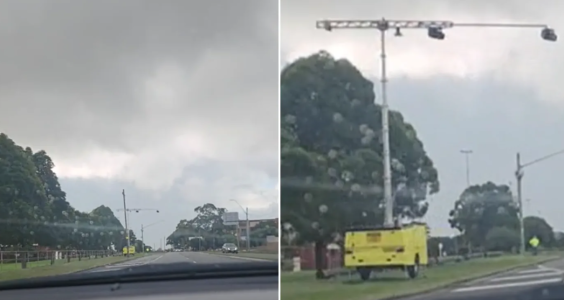Alert to Aussie drivers: Is increased roadside surveillance putting your privacy at risk?
As we navigate the roads of our sunburnt country, the watchful eyes of technology are ever-present, and for millions of Aussie drivers, the surveillance has reached unprecedented levels.
The debate over privacy versus safety was reignited by a recent discovery that has left many motorists feeling uneasy about the extent of roadside monitoring.
A Sydney driver, Layla Ellaz, recently stumbled upon a curious sight in Punchbowl, in the city's southwest.
A small crane-like structure equipped with a camera was perched on the side of a suburban road, silently capturing images of unsuspecting drivers.
Ellaz criticised the placement of the portable mobile phone detection camera, calling it a ‘violation of privacy’ despite its intended purpose of improving road safety.
‘Ah, the joys of modern technology, where even our cars are under the watchful eye of Big Brother, or shall we say, Big Camera!’ she said.
‘While I fully support the crackdown on distracted driving, it seems the enforcement method is reaching new heights—literally. Who knew that the next time we buckle up, we're also posing for aerial snapshots?’ she added.
Ellaz's encounter with this high-tech sentinel was shared on social media, where it quickly became a hot topic.
The camera, mounted on a yellow trailer with a metal arm extending over the road, was cleverly disguised to blend in with street lights.
This camouflage led to questions about the transparency of such surveillance methods and whether motorists should be alerted to their presence.
The debate is not just about being watched; it's about the angle of observation.
Ellaz continued: ‘If only our vehicles came with a 'privacy mode' button to shield us from unintended crotch and cleavage captures.’
‘At the very least, a sign indicating the presence of the device or acknowledgement of photo capture would level the playing field.’
While many social media users agreed with Ellaz’s concerns, some pointed out the benefits of the cameras.
One person asked: ‘Do you realise these are put in place to protect your safety?’
‘Once you lose a loved one from someone not paying attention while driving, I’m sure you’ll change your mind, privacy concerns or not,’ a different commenter pointed out.
In response to the uproar, a Transport for New South Wales spokesperson assured the public that the operation of these cameras complies with the Privacy and Personal Information Protection Act 1998.
They said: ‘Transport for NSW and Revenue NSW adhere to the Act in its operation of the mobile phone cameras and all other safety camera programs.’
‘When a potential offence is detected, images will be pixelated and cropped to protect privacy before the images are adjudicated by authorised staff,’ they added.
Moreover, any images not evidencing an offence are permanently deleted, typically within an hour.
The penalty for using a mobile phone while driving is steep: $387, or $514 in a school zone, along with five demerit points.
They also explained the lack of warning signs for mobile detection cameras, stating: ‘The program focuses on deterring drivers from illegal mobile phone use while driving by enabling anywhere, anytime detection, hence there are no warning signs for these cameras.’
‘If people believe they are likely to get caught and penalised, they are less likely to commit an offence,’ the spokesperson added.
Despite the backlash, road safety advocates like the National Roads and Motorists' Association (NRMA) support the technology, emphasising its life-saving potential.
Peter Khoury from the NRMA explained: ‘Once people start to take their eyes off the road, it’s almost like driving drunk in terms of their capacity to drive a vehicle safely.’
‘The laws were brought in and this technology was brought in as a preventative measure... to stop people getting behind the wheel and taking risks that jeopardise the safety of others.’
The NSW Council of Civil Liberties also weighed in, dismissing privacy concerns as long as the photographs are taken on public roads.
A spokesperson said: ‘There is no privacy concern for photographs taken of the inside of vehicles driving on public roads.’
 Have you encountered these cameras, members? Do you feel safer knowing they're there, or does it feel like an overreach into your personal space? Share your thoughts in the comments below!
Have you encountered these cameras, members? Do you feel safer knowing they're there, or does it feel like an overreach into your personal space? Share your thoughts in the comments below!
The debate over privacy versus safety was reignited by a recent discovery that has left many motorists feeling uneasy about the extent of roadside monitoring.
A Sydney driver, Layla Ellaz, recently stumbled upon a curious sight in Punchbowl, in the city's southwest.
A small crane-like structure equipped with a camera was perched on the side of a suburban road, silently capturing images of unsuspecting drivers.
Ellaz criticised the placement of the portable mobile phone detection camera, calling it a ‘violation of privacy’ despite its intended purpose of improving road safety.
‘Ah, the joys of modern technology, where even our cars are under the watchful eye of Big Brother, or shall we say, Big Camera!’ she said.
‘While I fully support the crackdown on distracted driving, it seems the enforcement method is reaching new heights—literally. Who knew that the next time we buckle up, we're also posing for aerial snapshots?’ she added.
Ellaz's encounter with this high-tech sentinel was shared on social media, where it quickly became a hot topic.
The camera, mounted on a yellow trailer with a metal arm extending over the road, was cleverly disguised to blend in with street lights.
This camouflage led to questions about the transparency of such surveillance methods and whether motorists should be alerted to their presence.
The debate is not just about being watched; it's about the angle of observation.
Ellaz continued: ‘If only our vehicles came with a 'privacy mode' button to shield us from unintended crotch and cleavage captures.’
‘At the very least, a sign indicating the presence of the device or acknowledgement of photo capture would level the playing field.’
While many social media users agreed with Ellaz’s concerns, some pointed out the benefits of the cameras.
One person asked: ‘Do you realise these are put in place to protect your safety?’
‘Once you lose a loved one from someone not paying attention while driving, I’m sure you’ll change your mind, privacy concerns or not,’ a different commenter pointed out.
In response to the uproar, a Transport for New South Wales spokesperson assured the public that the operation of these cameras complies with the Privacy and Personal Information Protection Act 1998.
They said: ‘Transport for NSW and Revenue NSW adhere to the Act in its operation of the mobile phone cameras and all other safety camera programs.’
‘When a potential offence is detected, images will be pixelated and cropped to protect privacy before the images are adjudicated by authorised staff,’ they added.
Moreover, any images not evidencing an offence are permanently deleted, typically within an hour.
The penalty for using a mobile phone while driving is steep: $387, or $514 in a school zone, along with five demerit points.
They also explained the lack of warning signs for mobile detection cameras, stating: ‘The program focuses on deterring drivers from illegal mobile phone use while driving by enabling anywhere, anytime detection, hence there are no warning signs for these cameras.’
‘If people believe they are likely to get caught and penalised, they are less likely to commit an offence,’ the spokesperson added.
Despite the backlash, road safety advocates like the National Roads and Motorists' Association (NRMA) support the technology, emphasising its life-saving potential.
Peter Khoury from the NRMA explained: ‘Once people start to take their eyes off the road, it’s almost like driving drunk in terms of their capacity to drive a vehicle safely.’
‘The laws were brought in and this technology was brought in as a preventative measure... to stop people getting behind the wheel and taking risks that jeopardise the safety of others.’
The NSW Council of Civil Liberties also weighed in, dismissing privacy concerns as long as the photographs are taken on public roads.
A spokesperson said: ‘There is no privacy concern for photographs taken of the inside of vehicles driving on public roads.’
Key Takeaways
- A Sydney driver, Layla Ellaz, raised concerns about mobile phone detection cameras that take pictures from above, arguing it is an ‘invasion of privacy’.
- There is criticism over the lack of warning signs before the location of such cameras, as is mandatory for mobile roadside speed cameras within the state.
- Transport for NSW stated that the operation of these cameras adheres to the Privacy and Personal Information Protection Act 1998, with images being pixelated and cropped to protect privacy before review.
- Advocates like the NRMA support the technology as a lifesaver and deterrent against illegal mobile phone use while driving, despite some public backlash.








